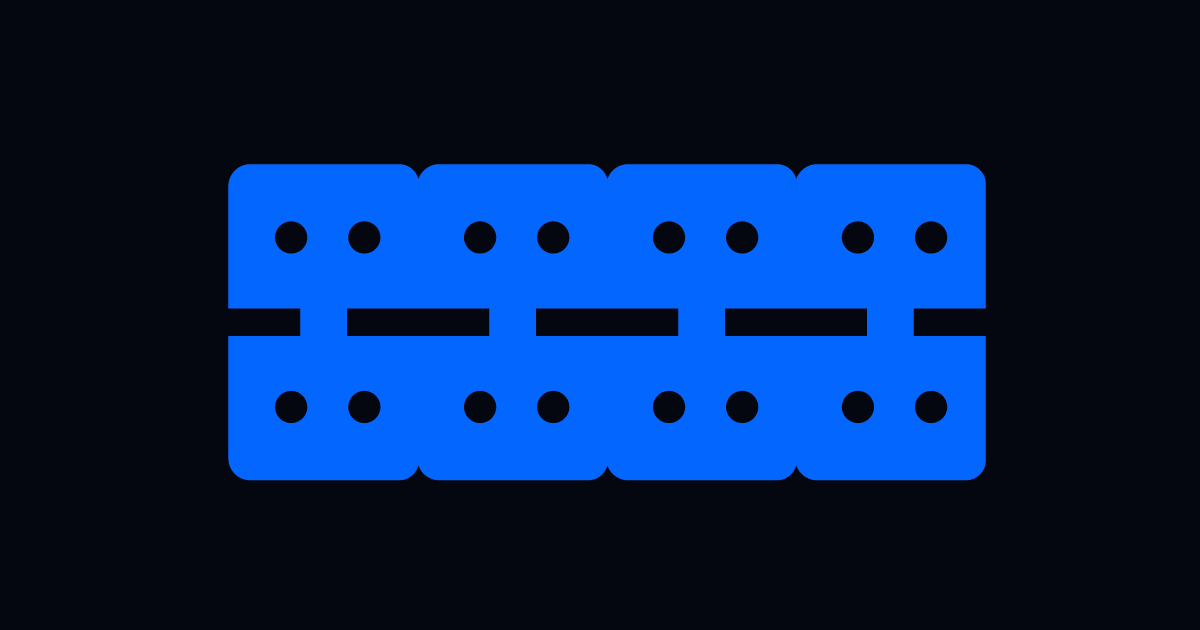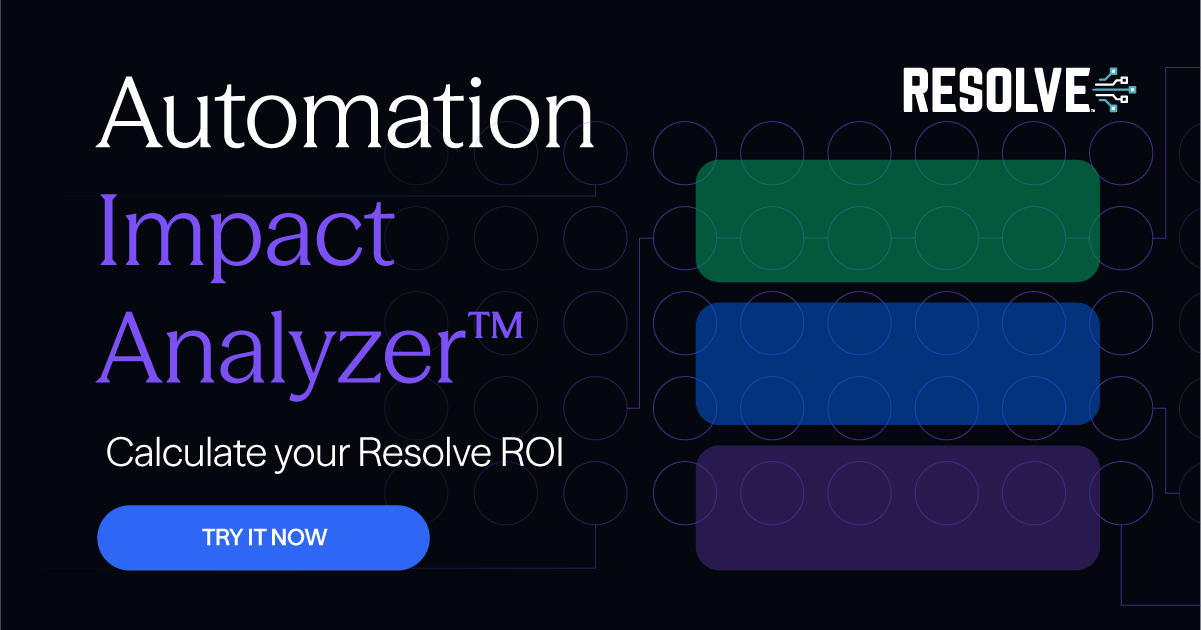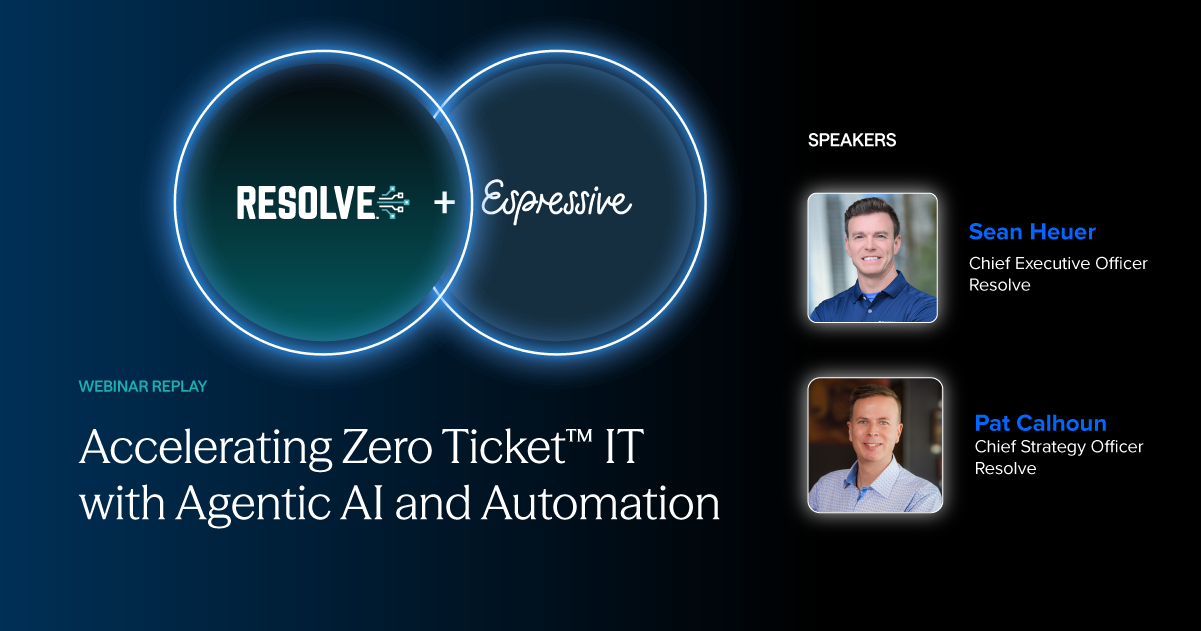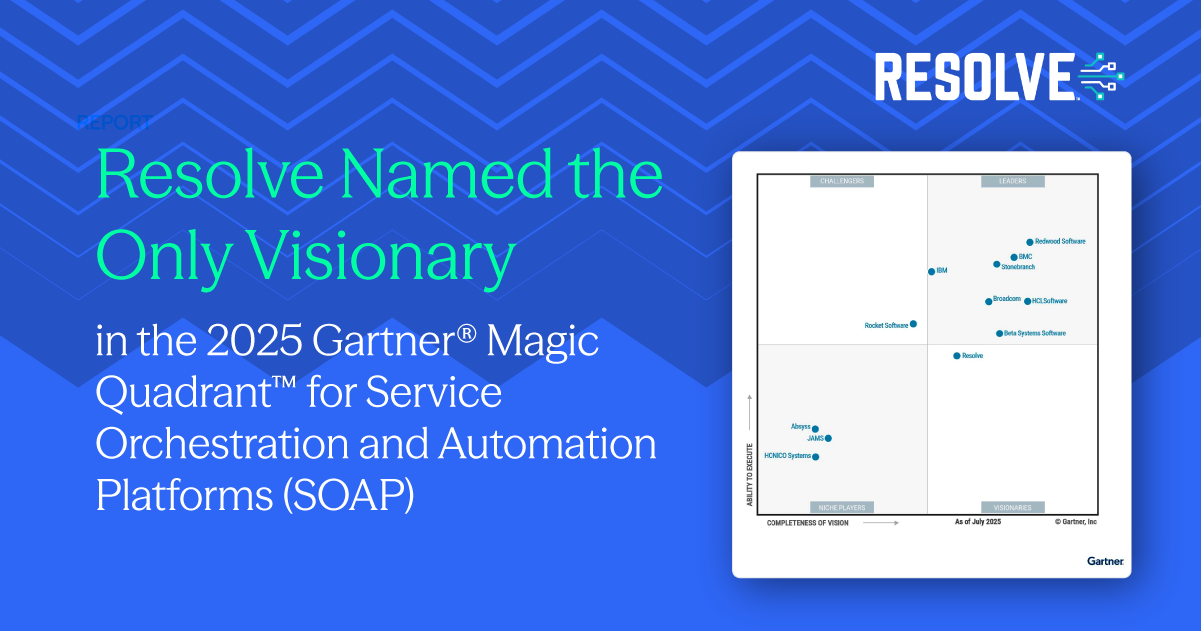
IT Process Improvement Is Great... If You Can Find Someone to Build It
Subscribe to receive the latest content and invites to your inbox.
IT leaders know the value of process improvement. Smoother onboarding, faster incident resolution, streamlined change management, etc. It’s not for lack of ideas that IT teams fall short; it’s almost always a lack of bandwidth.
Because of that, most process improvement efforts stall before they scale. Great ideas get captured in diagrams, Confluence pages, and strategy decks, but they rarely make it into production. Why? Because there aren’t enough people who can turn those ideas into working automations.
The builder bottleneck is real, and it's growing. Fortunately, there's a new way forward: Resolve's agentic automation platform and Zero Ticket IT model shift process improvement from theory to reality without requiring an army of automation engineers.
READ MORE: Got AI Fear? You Shouldn’t; It’s Coming for Your Busywork, Not Your Job
Why IT Process Improvement Efforts Stall
Despite the popularity of process improvement frameworks, most IT organizations struggle to move from concept to execution. Workflows remain manual. Teams remain reactive. The pressure to improve is mounting, but traditional methods can’t keep up.
More specifically, here are three core reasons IT process improvement stalls:
- Manual friction: Every improvement idea needs a builder, but skilled automation engineers are in short supply.
- Fragmented tooling: Process design, automation, and execution are often siloed, creating translation gaps.
- IT sprawl: With so many systems, services, and stakeholders, even small improvements require orchestration across platforms.
Even the best-designed processes will remain theoretical without a scalable path to execution. This problem results in stalled network and infrastructure automation. Organizations can begin to remediate this issue, though, by taking a close look at one of the first threats to scalability: builder bottlenecks.
The Builder Bottleneck: Today’s Most Overlooked IT Challenge
You can design a perfect workflow for access provisioning or change approvals... but who’s going to build it? In most enterprises, the answer is one platform expert, maybe more. Everyone else is waiting in line.
The result is a growing backlog of automation requests. IT leaders have visibility into what needs improvement, but no practical path to execute. What starts as a process optimization strategy becomes a documentation exercise. Intent gets stuck in limbo.
And the deeper problem? Even when time frees up, priorities shift. That brilliant workflow improvement drafted two quarters ago might now be outdated, overtaken by urgent tickets or strategic pivots. Teams are caught in a loop: documenting process improvement needs without any mechanism to act on them. For organizations focused on operational excellence or digital transformation, this represents a dangerous blind spot. Valuable ideas decay over time, not because they’re flawed, but because the execution layer can’t catch up. That’s the true cost of the builder bottleneck.
This bottleneck is more than a productivity problem. It slows innovation, increases risk, and prevents teams from responding to change. Meanwhile, business expectations continue to rise.
Zero Ticket IT: The Strategic Path to Process Execution at Scale
Zero Ticket IT isn’t just about deflecting service desk tickets. It’s about rethinking how work gets done. Instead of routing requests through ticket queues and human triage, Zero Ticket IT handles issues at the source before they become tickets at all.
This model is powered by Resolve’s AI agents:
- RITA, the Resolve IT Agent, deflects and resolves IT requests without human intervention. It automates tasks like password resets, VPN issues, and access provisioning, cutting ticket volume by 50% or more.
- Jarvis, Resolve’s automation architect, converts plain-language descriptions into tight workflows. While Jarvis builds, RITA keeps bandwidth clear by resolving repeatable tickets autonomously, allowing teams to focus on higher-value work.
Together, these agents close the gap between design and execution. Process improvement moves from whiteboard to working automation in days, not months.
READ MORE: The Future of IT Operations Is Zero Ticket
How Agentic AI Changes the Game
Unlike traditional automation tools, agentic AI doesn't just respond; it acts. These agents are goal-oriented, able to interpret intent, plan steps, take actions, and learn from outcomes.
Jarvis understands the business logic behind a request and transforms it into orchestrated workflows using natural language, while RITA handles real-time resolution of frontline IT issues through either autonomous or through guided technician support. Together, they eliminate the builder bottleneck and unlock continuous process improvement, turning vision into action without requiring deep platform expertise.
Practical Outcomes: Process Improvement Without the Wait
The biggest obstacle to process improvement is a lack of builders, not a lack of ideas. Agentic AI changes that. By removing the need for deep scripting expertise and automating the most repetitive tasks, Resolve clears the execution path so that great ideas don’t get stuck in limbo.
When the builder bottleneck is removed, outcomes accelerate:
- Up to 50% reduction in ticket volume within six months using RITA’s pre-built workflows. This frees overburdened teams from repetitive requests like password resets and VPN troubleshooting—giving them the bandwidth to contribute to higher-value work.
- 70% faster mean time to resolution (MTTR) through real-time resolution and guided technician support. With RITA handling the frontline and Jarvis turning natural language into workflows, teams no longer wait on platform experts to operationalize fixes.
- 40% or more reduction in ITSM spend by minimizing manual work and the need for additional fulfillment and approver licenses.
These aren’t hypothetical gains; they’re direct responses to a real-world constraint: not enough people with the time or technical depth to turn process improvement into production automation.
With agentic AI, the design-to-execution loop collapses:
- Access provisioning becomes self-service and policy-driven, not a weeklong ticket chain.
- Change approvals follow automation logic, not inbox delays.
- Recurring alerts trigger orchestrated remediation—no tickets, no waiting.
This gives teams superpowers they didn’t have before: the ability to act on their ideas immediately, without getting bogged down in scripting or waiting for engineering resources.
The Strategic Takeaway
Process improvement is not an execution problem; it’s a bandwidth problem. Without people and elbow room to implement ideas, strategy becomes shelfware.
Zero Ticket IT, powered by Resolve’s agentic AI platform, turns process intent into execution. It eliminates bottlenecks, empowers teams, and accelerates improvement without adding headcount. For CIOs and I&O leaders looking to modernize operations and scale automation, this is the model that makes it possible.
Ready to harness agentic AI and the Zero Ticket vision for yourself?
→ Request a Demo
→ Read The Zero Ticket Future Manifesto






